Retro Review: Tseng Labs ET4000AX Part 1
29th October 2022
You may have come across this card in some of my retro motherboard reviews, as it's one of my 'go-to' cards. The Tseng Labs ET4000 was one of the most successful Super VGA chipsets on the ISA bus in the late 80s and 90s. Whilst it was definitely one of the fastest, it was slightly beaten on performance by a couple of other cards at the time, but was a great all-rounder with decent compatibility.
My original 16-bit ISA ET4000 card (ca. 1992)
There were several variants of the ET4000AX, with code numbers TC6058AF, TC6059AF, and TC6100AF. Mine has a TC6100AF, which in other benchmark tests I've seen online appears to perform slightly faster than the older two.
My card has no obvious manufacturer logos or model numbers, but the FCC ID indicates it's from a company called Britek Electronics Co Ltd. Britek were based in Taipei, Taiwan, and produced graphics cards and some sound cards from 1990 up until early 1999. You may recognise them by their brand name that was often used, ViewTOP.
Tseng Labs never produced their own cards, instead focussing on creating a high quality chipset with reference board designs for card manufacturers to follow. In fact, so good was the original ET4000AX chip, Tseng Labs extended it, creating the ET4000BX, ET4000/W32 (for VESA Local Bus), ET4000/W32i (VLB with interleaved DRAM) and ET4000/W32p (for PCI bus).
The Flypast
So what component parts make up this nice 16-bit ISA graphics card? It appears to have:
- A Tseng Labs ET4000AX ASIC, revision TC6100AF
- A VGA BIOS chip
- A Sync ROM chip
- A 32K Hi-Color RAMDAC
- A single crystal oscillator
- A 15-pin D-SUB for digital video out
- Two banks of Sanyo-branded DRAM chips
- An ICS2494N video/memory clock generator
- A single jumper to change the interrupt the card uses
Looking around the net for similar-looking cards, I found these:
From the top row, they are:-
- ViewTOP (ILLTS4HV) - another card from the same manufacturer as mine, but its RAMDAC is a 44-pin PLCC instead (a Samsung KDA0476PL-80 which is a standard VGA colour palette of 256 colours max and runs at 80 MHz). It has 1 MB of OKI-branded 70ns DRAMs and a TC6100AF.
- ViewTOP (ILLTS4HV) - 1 MB of OKI-branded 70ns DRAMs, its RAMDAC is a MUSIC Semiconductor TR9C1710-800CA, which provides 256 colours maximum and runs at 80 MHz. It has a TC6100AF.
- Diamond SpeedSTAR - a prominent card that sold well. The card has 1 MB of DRAM in a combo of GoldStar 60ns and Sanyo 70ns chips. It has the same RAMDAC as (2) above, and has the oldest ET4000AX revision, TC6058AF.
- Diamond SpeedSTAR VGA - 1 MB of Texas Instruments 80ns DRAMs. This card has an AT&T-branded ATT176D-66P28 RAMDAC in a 28-pin DIP package. I was unable to find any info on this chip, but it's probably a rebadged MUSIC Semi one like (2) and (3) above but runs at the slower 66 MHz and is in a different package. Like the original SpeedSTAR, it has the earliest revision of the ET4000AX chip, TC6058AF.
And on the bottom row:-
- Diamond SpeedSTAR24 - 1 MB of Samsung-branded KM44C256CP super-fast 60ns DRAMs, and a Sierra Semiconductor 44-pin PLCC RAMDAC, model SC11483CV which is a Hi-Color DAC (32,768 colours). There's no speed indication on the chip but these came in 50, 66 and 80 MHz flavours. It has the TC6100AF variant of the ET4000AX chip.
- STB Powergraph - 512 KB of NMB Semiconductor AAA1M304P 70ns DRAMs, and the same RAMDAC as the top ViewTOP card above, except in a 28-pin DIP package. It has the TC6058AF variant of the ET4000AX chip.
- Genoa Systems Multimedia VGA Model 7900 - 1 MB of Texas Instruments 80ns DRAMs and an unknown RAMDAC. It has the TC6100AF variant of the ET4000AX chip.
Video Controller
The Tseng Labs ET4000 was their 6th graphics chip, succeeding among others, ET1000, ET2000 and ET3000. It was fabricated in both 144-pin and 160-pin PQFP (Plastic Quad Flat Package) forms, created using a 1.0 micron manufacturing process. The ET4000 provided register-level compatibility with all the PC graphics standards of the day, including MDA, CGA, EGA, VGA, Hercules (HGC), and even AT&T/Olivetti! It supported interlaced and non-interlaced V-Sync and H-Sync signals with polarity control output to your monitor, so was very much at home with a multisync analogue monitor. With 1 MB of video memory onboard, an ET4000 could display resolutions up to 1024 x 768 in 256 colours.
Internally the ET4000 comprised a graphics data controller, Memory Control Unit (MCU), several caches, a System Priority Controller (SPC), a CRT (Cathode Ray Tube) controller, a display address controller and attribute controller.
It was able to support 50 to 70 Hz vertical refresh rates and screen resolutions up to 1024 x 768.
After extending the life of the ET4000 through its minor successors (ET4000BX and ET4000/W32 series), Tseng went onto create the ET6000, ET6100 and ET6300.
I have no information on the ET4000BX.
The ET4000/W32, W32i and W32p added hardware BitBLT (Bit Block Transfer) operation support and a hardware cursor sprite. The W32 (no 'P') and W32i were designed for the VESA Local Bus, while the W32p was the same card but designed for the PCI bus. For all these, data throughput of the venerable ET4000 was much improved. Another key upgrade was support for 32-bit asynchronous EDO/FPM DRAM memory with transfer speeds up to ~56 MB/s. W32 cards tended to come with 1 MB of DRAMs onboard, but the W32i further increased performance by offering interleaved memory if 2 MB or 4 MB of video memory was installed. The W32 cards competed directly against S3 and ATI cards of the same era.
VGA BIOS and Sync ROM
.jpg) The Super VGA BIOS is a 28-pin 27256 EPROM chip (256-kbit), which means it's 32 KB in capacity. It contains all the usual display modes for EGA and VGA (for MDA and CGA there was no need for a separate video BIOS, as the main PC BIOS contained all the necessary BIOS calls for accessing the video). There are numerous versions of the ET4000's VGA BIOS available to download on the web, so I won't post any here.
The Super VGA BIOS is a 28-pin 27256 EPROM chip (256-kbit), which means it's 32 KB in capacity. It contains all the usual display modes for EGA and VGA (for MDA and CGA there was no need for a separate video BIOS, as the main PC BIOS contained all the necessary BIOS calls for accessing the video). There are numerous versions of the ET4000's VGA BIOS available to download on the web, so I won't post any here.
I'm not 100% sure what the VGA Sync ROM is for; my guess is that it's an EPROM that contains mappings of all the video modes supported by the ET4000 along with the various frequency timings and polarities. In theory this information could have been baked into the VGA BIOS chip though.
**UPDATE** A Vogons contributor (mkarcher) wrote this about the sync ROM: "ET4000 cards were quite popular those days. Some of them can be switched in CGA/EGA emulation modes where they are (mostly) register-level compatible to those cards. If there is a chip labeled "SYNC ROM", this is definitely the case - that ROM contains translation table from CGA or EGA values to VGA values for CRTC programming.".
So I think my theory is correct. Also, I read on Target Earth about an ET4000-based card that does not have the Sync ROM chip installed (just an empty socket). The author there states that "The BIOS for this card is in a single 64kbyte ROM, rather than seperate 32kbyte MAIN and SYNC ROM chips.". So it seems some cards didn't require the VGA Sync ROM chip, and instead came with a larger single ROM chip that combined the contents of both, or omitted emulation modes.
RAMDAC
.jpg) When VGA arrived on the scene, RAMDACs became necessary because our PC graphics cards up until this point all output digital signals (MDA, Hercules, CGA and EGA), but VGA instead output analogue signals. The RAMDAC is exactly as you might expect, it's a Random Access Memory (RAM) chip used to convert digital signals to analogue (a DAC) for output to the monitor. The digital image that's stored in the frame buffer (the video card's memory) is sent to the RAMDAC, where three internal digital-to-analogue converters convert each of the red, green and blue digital values to an analogue signal using a colour table, aka colour map or LUT (lookup table) that is stored in static RAM embedded within the RAMDAC chip to tell it what each colour should look like. Each red, green and blue value is then converted to a voltage that's sent to the monitor.
When VGA arrived on the scene, RAMDACs became necessary because our PC graphics cards up until this point all output digital signals (MDA, Hercules, CGA and EGA), but VGA instead output analogue signals. The RAMDAC is exactly as you might expect, it's a Random Access Memory (RAM) chip used to convert digital signals to analogue (a DAC) for output to the monitor. The digital image that's stored in the frame buffer (the video card's memory) is sent to the RAMDAC, where three internal digital-to-analogue converters convert each of the red, green and blue digital values to an analogue signal using a colour table, aka colour map or LUT (lookup table) that is stored in static RAM embedded within the RAMDAC chip to tell it what each colour should look like. Each red, green and blue value is then converted to a voltage that's sent to the monitor.
RAMDACs were later embedded into the graphics chip in order to reduce manufacturing costs as well as latency in retrieving data from another chip, but on these boards they're not only separate, but are interchangeable! My card here has a "32K Hi-Color" DAC. Around the time of Super VGA, two new terms started cropping up: Hi-Color and TrueColor (more info on these can be found on my Graphics page in the link at the top). Basically, the VGA standard only catered for what we call 4- and 8-bit colour depth, which allows for 16 and 256 colours displayed simultaneously, respectively. With SVGA cards, "Hi-Color" means your card can support 15-bit or 16-bit colour depths, which translates to 32,768 colours. "TrueColor" was 24- or 32-bit colour depth, which provided 256 different shades of red, 256 shades of green and 256 shades of blue, resulting in a total of 16.7 million different colours your card could output. TrueColor was actually an option on the ET4000 with the installation of an ICS5301-1 80 MHz or ICS5301-2 110 MHz TrueColor RAMDAC. Of course, to support more colours at the same resolution you also need more video memory to be able to hold all that information (1 MB as a minimum).
The RAMDAC on my board is a 28-pin DIP and of course I cannot see the chip make and model without removing the sticker (something I don't want to do). Other ET4000 cards I've referenced further up use a Samsung KDA0471PL or KDA0476PL, which has the basic VGA 256-colour palette only. Some DOS system information utilities tell me mine is a Sierra Semiconductor 32K HiColor DAC, most likely an SC11482, SC11483 or SC11484.
Video Memory
.jpg) The ET4000 can support memory sizes of 256 KB, 512 KB and 1 MB. This SVGA card has eight LC324256AP-80 DRAM chips which are 256 Kbit x 4, resulting in a total memory capacity of 1 MB. They are all rated for a middle-of-the-road 80ns access time.
The ET4000 can support memory sizes of 256 KB, 512 KB and 1 MB. This SVGA card has eight LC324256AP-80 DRAM chips which are 256 Kbit x 4, resulting in a total memory capacity of 1 MB. They are all rated for a middle-of-the-road 80ns access time.
Fortunately for me, all the memory is socketed, and as I've identified other manufacturers used chips as fast as 60ns so it might be worth sourcing eight of those and seeing if there's any performance gain with faster DRAMs. It's likely though that other aspects of the card or the ISA bus itself would be a bottleneck to much, if any, improvement. There is also the option on some motherboards to overclock the ISA bus, which I will also do.
Crystal Oscillator
There is just one crystal oscillator on the card, which runs at 14.31818 MHz. Unlike EGA cards that often had multiple crystal oscillators to run at different pixel clocks (dot clocks) / refresh rates, the ET4000 chip itself produces a variety of clock sources to handle all the frequencies of the many different display modes it supports. This crystal is coupled to an ICS2494N video clock generator, which runs at 89.8 MHz. The clocks generated are 25.175 MHz (for VGA mode), 28.322 MHz (for VGA and CGA modes), 32.514 MHz (for EGA mode), and 40.0 MHz (for "Extended" modes).
Summary Part 1
In Part 2, I will test the card is fully functional and run some benchmarks to see what we can get out of it. I mentioned at the start that I put this into several motherboard tests in the past, including my Chips & Technologies 386 review and the Fast 286 review. In both of these, the ET4000 was marginally beaten by two cards that ran 70ns DRAMs - a Western Digital WDC90C30 and a Trident TVGA-8900CL-B.
.jpg)
.jpg)
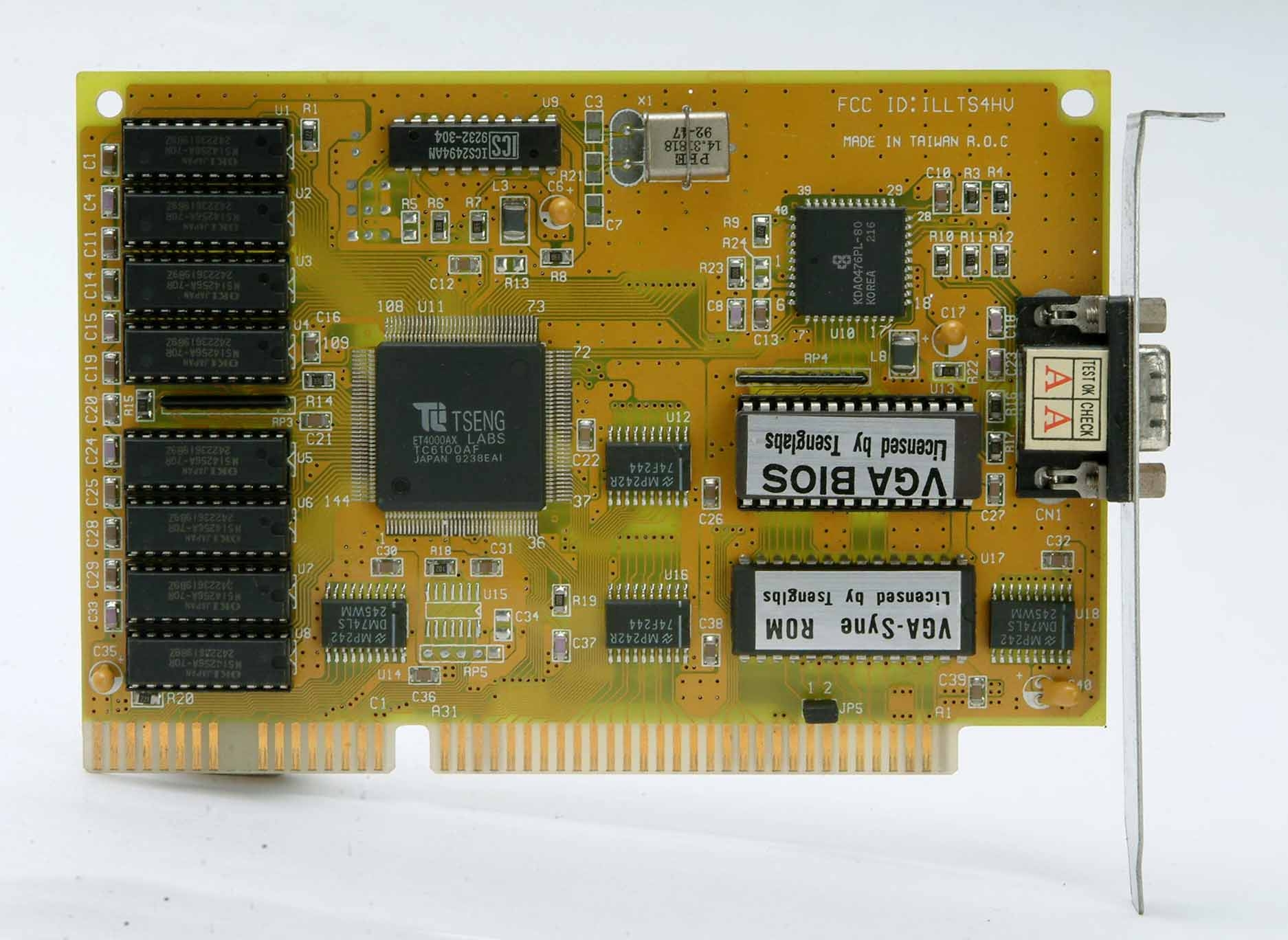
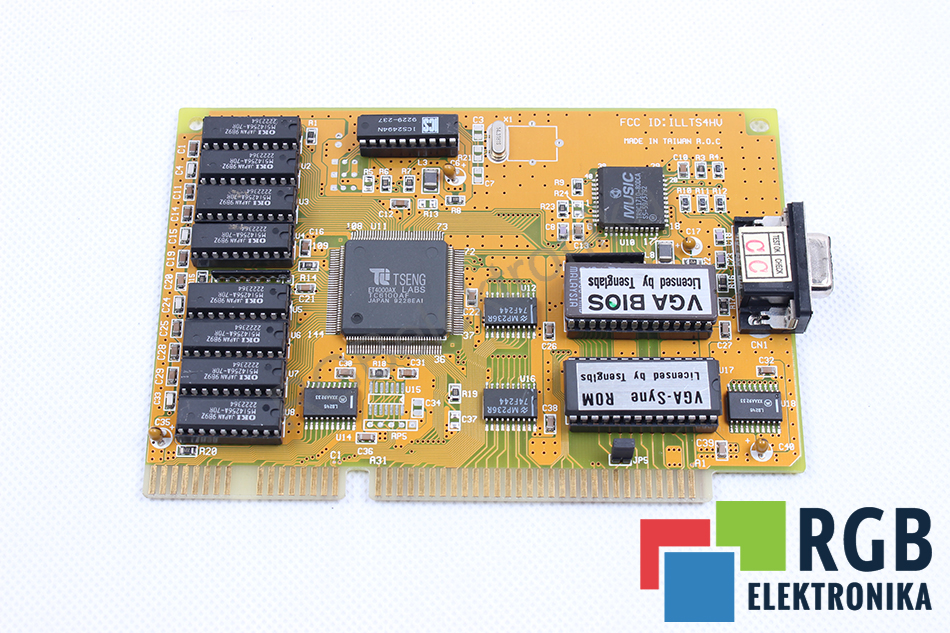
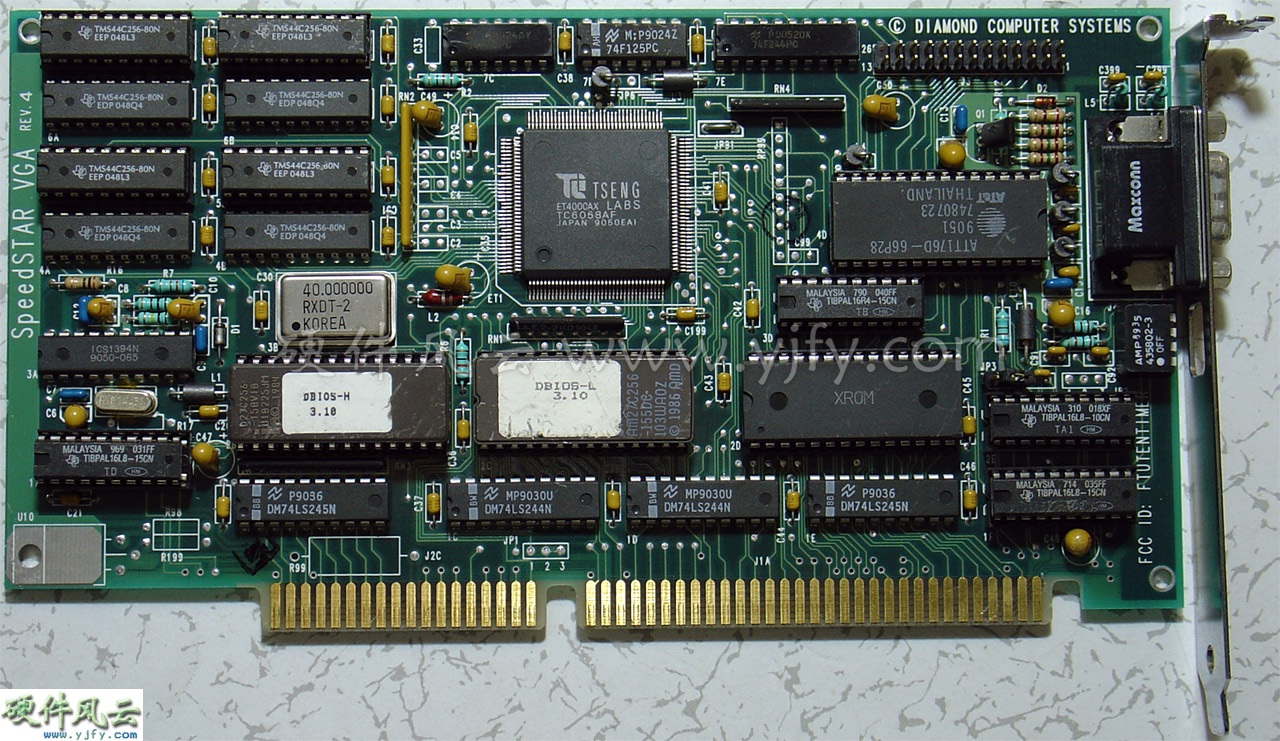
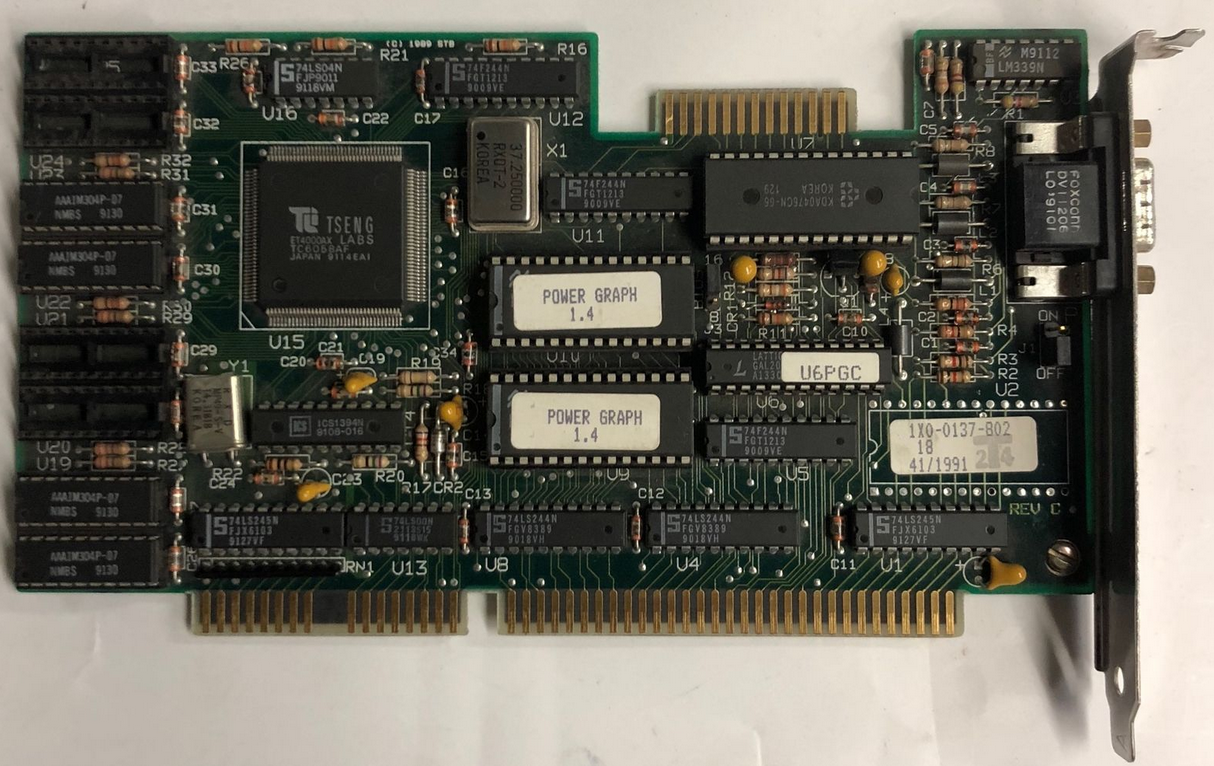
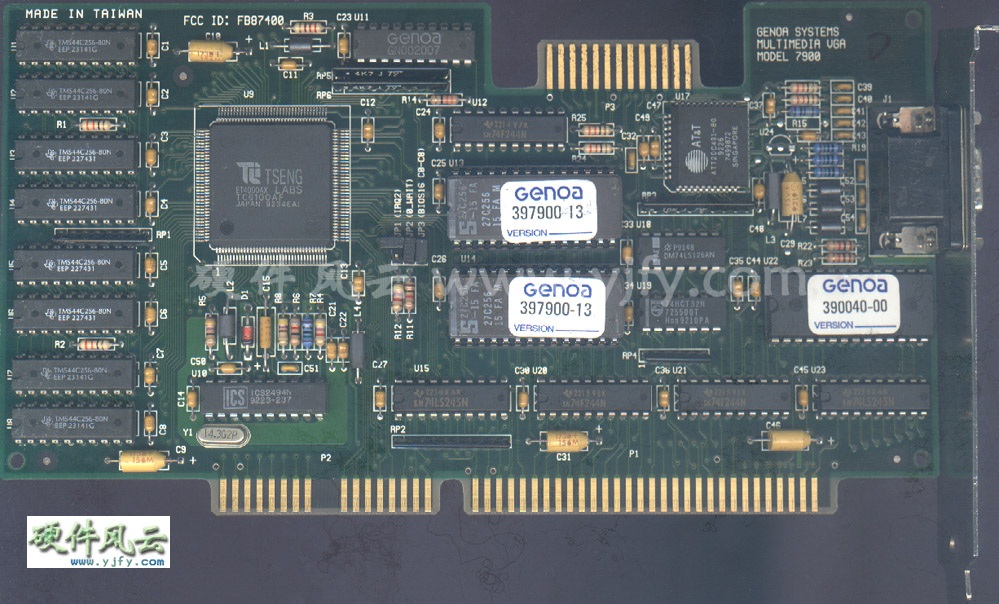
.jpg)